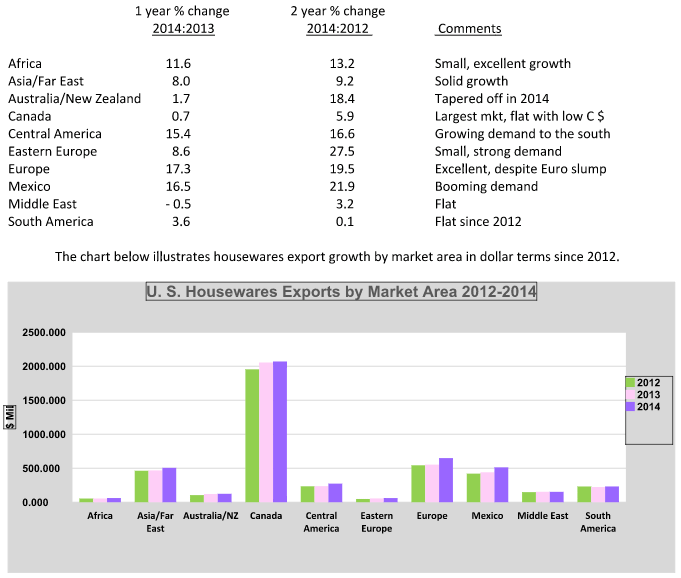U.S. Housewares exports turned in a spectacular performance in 2014. Total exports rose 6.4% reaching over $ 4.6 billion in sales for the year! Since 2012 exports have soared 10.5% and every product category has increased substantially.
Some factors that contributed to the rise included the low U.S. dollar rate which lasted into early 2014 making exports easier to price, strong relationships that suppliers developed over many years, sheer persistence, and the perceived quality of U.S. housewares offerings.
Both the one and two-year trends are solid and point to commitment and further opportunities for growing business through export. On a percentage basis by category, housewares exports grew as follows:

Geographically, Housewares exports have increased to every market area in the world except for a minor dip to the Middle East in 2014. The percentage changes by market area are as follows:

There are many reasons why U.S. Housewares exporters performed well in 2014. U.S. housewares products are in demand for their new designs, quality, functions, materials, convenience and price. In addition, with years of experience in general, U.S. exporters are better prepared for market entry, have increased market awareness and access to improved market intelligence. Savvy marketers are aware of buyer practices and customs and are willing and able to adapt to make the sale.
Combining the two measures of export sales by product category and by geographic region, the category leaders in terms of percentage growth by region included:

In summary, the export data and trends presented for these past two years indicate U.S. Housewares suppliers stand to benefit substantially by periodically evaluating your plans to penetrate international markets. If your company is new-to-market it may be valuable to consider easier markets with less risk and cost involved in market entry. For experienced exporters, it may be time to evaluate additional markets in regions where you are already active to broaden market penetration. With a strengthening U.S. dollar your ability to price competitively may be hampered and that element should be factored into your decision-making. In a time when better and faster dominates, the value of established relationships can provide an important edge to future negotiations. Good luck with your efforts!
Report and analysis by: Laura Spingola, Trade Resources Ltd., Chicago, IL
+1.312.939.5030 / LSpingola@TradeResources.com


